Spring Rolls or Egg Rolls: What Sets Them Apart?
Spring rolls and egg rolls create confusion for many food enthusiasts across different cuisines.
Cylindrical appetizers might seem similar at first glance, yet subtle differences make each one special in its own way.
The thin, translucent wrapper of spring rolls offers a delicate crunch, while egg rolls boast a thicker, bubbled exterior after deep frying.
Many Asian countries have their own versions with regional ingredients and cooking techniques adding unique flavors.
Traditional spring rolls often contain vegetables and minimal meat, giving them a lighter profile compared to their hearty counterparts.
The distinct cooking methods also contribute to their different textures and appearances on serving platters.
Both these rolled delicacies have fascinating histories that reflect cultural exchanges throughout centuries of culinary evolution.
What makes these rolled treasures truly stand apart from each other? Let's dive deeper into their distinctive characteristics.
Spring Rolls: What Are They?
Spring rolls are a popular appetizer across China and many Asian countries, originating from a Chinese tradition of serving them during early spring celebrations.
They typically consist of a thin wrapper made from rice paper or wheat flour dough, filled with other ingredients like vegetables, meat, seafood, or noodles.
There are two main types of spring rolls:
Fresh Spring Rolls
Also called summer rolls or salad rolls, these are not fried. They are made with soft rice paper wrappers and filled with fresh ingredients like shrimp, herbs, vermicelli noodles, and crisp vegetables.
They are light, healthy, and often served with dipping sauces such as peanut sauce or nuoc cham (Vietnamese fish sauce dip).
Fried Spring Rolls
These are wrapped in a wheat-based dough and deep-fried until crispy and golden brown. The fillings vary widely and can include pork, chicken, vegetables, or mushrooms.
They are crunchy on the outside and savory inside, usually served hot with dipping sauces.
Overall Information About Egg Rolls
Egg rolls originated in 1930 when Chinese immigrant chef Lum Fung in New York adapted traditional spring rolls by adding eggs to the wrapper, creating a thicker, bumpier crust than the classic flour-and-water wrapper.
They’re wrapped in a thicker wheat-based dough (often called an egg roll wrapper, though it may or may not contain egg) and filled with a mixture such as shredded cabbage, carrots, pork or shrimp (or vegetarian versions), garlic, ginger, and seasonings.
The filled wrapper is rolled, sealed (usually with a slurry), and deep-fried until the exterior is crispy and golden.
Though they share a common format, egg rolls wear different regional touches, such as Southwest, Southern, taco-style, and more.
Vietnamese-style Egg Rolls (Chả Giò / Nem Rán)
The Vietnamese egg roll version, chả giò (also called nem rán in northern Vietnam), is a cornerstone of that global family. Unlike the thicker American-Chinese egg roll wrapper, Vietnamese egg rolls traditionally use rice paper (or in some regional/modern takes, thin wheat wrappers) that’s soaked briefly, filled with a fragrant mix of minced pork or shrimp, wood ear mushrooms, cellophane noodles (miến), jicama or taro, carrots, and aromatics like garlic and shallots.
They’re tightly rolled and deep-fried until lacy and crisp, then served with Vietnamese pickled vegetables (đồ chua) and a tangy fish sauce–based dipping sauce (nước chấm); they can also be wrapped in lettuce with fresh herbs for contrast.
Southwestern U.S. Egg Rolls
Southwestern-style egg rolls are a Tex-Mex–inspired reinterpretation that swaps the traditional cabbage-and-pork core for ingredients emblematic of the American Southwest.
Common fillings include black beans, corn, diced peppers or jalapeños, spiced chicken or seasoned ground beef, onions, and often pepper jack or cheddar cheese, sometimes with a hint of chili powder, cumin, or lime zest for brightness.
They’re wrapped (some recipes even riff with small flour tortillas or standard egg roll wrappers) and deep-fried until golden, then served with complementary sauces like creamy lime crema, salsa, or spicy ranch.
Southern U.S. Egg Rolls
Southern-style egg rolls take inspiration from classic soul food and Southern comfort dishes, embedding regional staples into the filling. Variations may include black-eyed peas (often from dishes like Hoppin’ John), collard greens, smoky bacon, sweet Vidalia onions, and cheeses such as Gruyère or pepper jack, sometimes paired with turnip greens or other local greens.
The mix can also incorporate elements like sausage for added richness. These fillings are enveloped in wrappers and deep-fried, delivering a crunchy exterior that contrasts with a creamy, savory, slightly earthy interior.
Flavor Journeys: Regional Spring and Egg Roll Delights
Many regional variations of spring rolls and egg rolls exist across different areas, each with their own special cooking methods and unique flavors. The recipes change from one place to another, creating a wide range of tastes for food lovers to enjoy.
Some versions are crispy while others have a softer wrapper, and the fillings can include everything from vegetables to seafood or meat. Local ingredients often determine what goes inside these popular appetizers, making each regional style distinct and worth trying.
People around the world have put their own spin on these rolled delights, adapting them to local preferences and available ingredients. Next time you try one, pay attention to the subtle differences that make each version special.
Taco-Style Egg Rolls
Taco egg rolls are a crossover between Tex-Mex and Asian-inspired hand-held fare. The core filling mimics classic taco components: seasoned ground beef or turkey (with taco seasoning and sometimes onions and peppers), salsa or Picante-style sauce, and a melting cheese like sharp cheddar or Mexican blend.
Some versions add diced green chiles, cilantro, or a touch of lime. They’re typically served with creamy dipping sauces (e.g., a spicy sour cream, avocado crema, or salsa-based dip) to echo taco toppings.
Spring Rolls vs Egg Rolls: Differences Between Them
Spring rolls and egg rolls often get confused, but they're completely different Asian appetizers with distinct traits.
This table shows you their distinctions briefly.
| Aspect | Spring Rolls | Egg Rolls |
| Cooking Method | Flexible: fried, steamed, baked, or served fresh (no exterior cooking). | Almost always fried (air fryer is a common oil-free alternative). |
| Wrapper Base | Flour + water; uses rice flour (SE Asia) or wheat flour. Thin and light. | Flour + water + egg; thicker and richer, giving more body. |
| Texture | Light, flaky or tender (depending on prep); thin shell. | Heavier: crunchy outside, slightly chewy inside. |
| Typical Fillings | Mostly vegetables and lean proteins (e.g., vermicelli, cabbage, shrimp, pork/chicken, bean sprouts). | Heartier, cooked mixes (e.g., cabbage, pork/ground beef, fusion additions like corn, black beans, taco-style beef with cheese). |
Cooking Method
Spring rolls are flexible in how they’re prepared: they can be fried for a light, crispy shell; steamed or baked for a softer, milder version; or served fresh (especially in Vietnam and Thailand) with only the filling cooked, wrapped in delicate rice paper or thin wheat wrappers.
That adaptability gives you options based on texture and richness, from crunchy and flaky to tender and bright with raw herbs and veggies.
Egg rolls, by contrast, are almost always fried - their thicker, egg-enriched wrapper is designed to be cooked in hot oil (or air-fried as a lower-oil alternative) to develop a golden, crunchy exterior; skipping the frying step would lose the signature heft and texture that define them.
Wrapper
The wrappers also differ at the ingredient level: spring roll wrappers are essentially made from flour and water, using rice flour or rice paper in Southeast Asia for a translucent, thin shell or wheat flour in some Chinese styles, keeping the casing light and flexible.
Egg roll wrappers add egg (and sometimes a bit of oil), which builds more structure into the dough - this makes the shell thicker, richer, and better able to hold up to hearty fillings and deep frying without falling apart.
Texture
That difference in wrapper composition directly affects mouthfeel. Spring rolls, whether fried or fresh, bite light - fried ones are crisp and flaky, and fresh ones are tender, so the filling tends to take center stage.
Egg rolls feel more substantial: their egg-enhanced wrapper yields a crunchy exterior with a slightly chewy interior, giving a pronounced contrast between shell and filling and a more filling, satisfying bite.
Filling Ingredients
Fillings for spring rolls are typically brighter and lighter, varying widely by region but often combining vegetables like shredded cabbage, carrots, bean sprouts, and herbs with proteins such as shrimp, pork, chicken, or tofu, sometimes layered with vermicelli noodles for texture.
Egg roll fillings, rooted in American-Chinese and fusion traditions, are usually cooked and heartier - common cores include cabbage, carrots, and pork or ground beef, with regional twists adding elements like corn, black beans, or taco-seasoned beef with cheese, resulting in savory, rich mixtures that pair with the thicker, fried wrapper.
Dipping Sauces for Spring and Egg Rolls
Dipping sauces is a must when enjoying spring and egg rools. They turn good rolls into unforgettable bites.
Whether you prefer spicy, sweet, savory, or bright Vietnamese-style, the right sauce brings everything into balance.
Spicy Sauces
For heat lovers, spicy sauces bring bright contrast to both spring rolls and egg rolls. Classic choices include Sriracha or other chili sauces; you can also try a chili-garlic paste, hot mustard, or a spicy peanut sauce for depth.
A dash of lime or a touch of honey can balance the heat if you want a layered spicy-sweet kick.
Sweet & Tangy Sauces
Sweet and tangy sauces complement the savory fillings by adding brightness and richness. Popular options are sweet-and-sour sauce, plum sauce, duck sauce, and hoisin.
These provide a glossy, slightly sticky counterpoint; use them straight or riff by stirring in a little ginger, orange zest, or sesame for extra nuance.
Vietnamese-style Nuoc Cham
The Vietnamese dipping sauce nước chấm is a balanced blend of fish sauce, lime (or rice vinegar), sugar, garlic, and chili. It’s thin, bright, slightly salty, and sweet with a hint of heat - initially unfamiliar to some because of the fish sauce base, but it quickly becomes addictive, especially with fresh spring rolls.
Remember to adjust the sugar and lime to taste for your ideal balance.
Spring Rolls vs. Egg Rolls: Which Is Healthier?
Spring rolls tend to be healthier than egg rolls mostly because of their lighter wrapper and flexible cooking methods: fresh or steamed spring rolls skip deep-frying entirely, and even fried versions usually have a thinner shell made from just flour and water (or rice), so they absorb less oil and feel less heavy.
Egg rolls use an egg-enriched, thicker wrapper and are almost always fried, which increases calories and fat; their denser shell also makes them more substantial per bite.
For a healthier take, opt for fresh or baked spring rolls loaded with vegetables and lean protein, or air-fry egg rolls with a controlled filling and serve with a light dipping sauce.
Homemade Spring and Egg Rolls: Let’s Try
Spring rolls and egg rolls make delicious treats for the whole family.
Both are simple to prepare at home with a few basic ingredients.
Keep reading to learn how to make them.
Making Fresh Spring Rolls
Ingredients:How to Make It:Making Egg Rolls
Ingredients:Steps to Make It:Shelf Life And Storing Guide of Spring and Egg Rolls
Proper storage is key to keeping spring rolls and egg rolls tasty and safe. Check this quick guide to their shelf life and how to store each so they stay crisp (or fresh) and ready to eat.
| Type | Fridge | Freezer |
| Fresh Spring Rolls | Up to 24 hrs, wrapped tightly with damp towel to prevent drying | Not recommended |
| Fried Spring Rolls | 3–4 days, cooled then stored in single layer (use parchment between) | Freeze solid on tray, then bag: 1–2 months |
| Egg Rolls | 3–4 days, same handling as fried spring rolls | Flash-freeze, then bag: 1–2 months |
For Spring Rolls (Including Fresh/Unfried)
Fresh spring rolls are best eaten the same day. If you need to store them briefly, wrap each tightly in plastic wrap (or place them seam-side down in an airtight container) with a slightly damp paper towel to keep the rice paper from drying out.
Refrigerate for up to 24 hours; after that the wrapper gets gummy and the herbs/vegetables lose their brightness. Don’t cut them too early; slice just before serving to preserve texture.
For Fried Spring Rolls
Fried spring rolls can be kept in the refrigerator in a single layer (or separated with parchment) inside an airtight container for 3–4 days. Let them cool to room temperature (but no longer than 2 hours out), then refrigerate.
To revive crispness, reheat in a hot oven or air fryer rather than the microwave. For longer storage, freeze on a tray until firm, then pack in a freezer-safe bag for 1–2 months; reheat from frozen in an oven or air fryer until hot and crisp.
For Egg Rolls
Store cooled egg rolls in the fridge in a single layer or separated with paper between them in an airtight container for 3-4 days. Reheat in an oven or air fryer to restore crunch.
For freezing, flash-freeze on a tray, then transfer to a sealed bag, keep up to 1–2 months, and cook directly from frozen to preserve texture.
Discard any roll (fresh or fried) if it smells off, becomes slimy, or has been left at room temperature over 2 hours.
Got Questions? We’ve Got Solutions
1. Are spring rolls healthier than egg rolls?
Spring rolls tend to be healthier as they're usually wrapped in thin rice paper and often steamed or served fresh. Egg rolls have wheat flour wrappers that are always deep-fried, making them higher in calories and fat.
2. Can I make both spring rolls and egg rolls ahead of time?
Egg rolls freeze well and can be made several days ahead. Spring rolls are best prepared shortly before serving as their delicate wrappers can become soggy or tear easily when stored.
3. What's typically inside each roll?
Spring rolls usually contain fresh vegetables, sometimes with shrimp or thin slices of meat. Egg rolls typically have a heartier filling with cabbage, carrots, bean sprouts, and ground pork or chicken.
4. Which roll is easier for beginners to make at home?
Egg rolls are generally easier for beginners because their wrappers are more forgiving and don't tear as easily as spring roll wrappers, which require a gentle touch and some practice to handle properly.

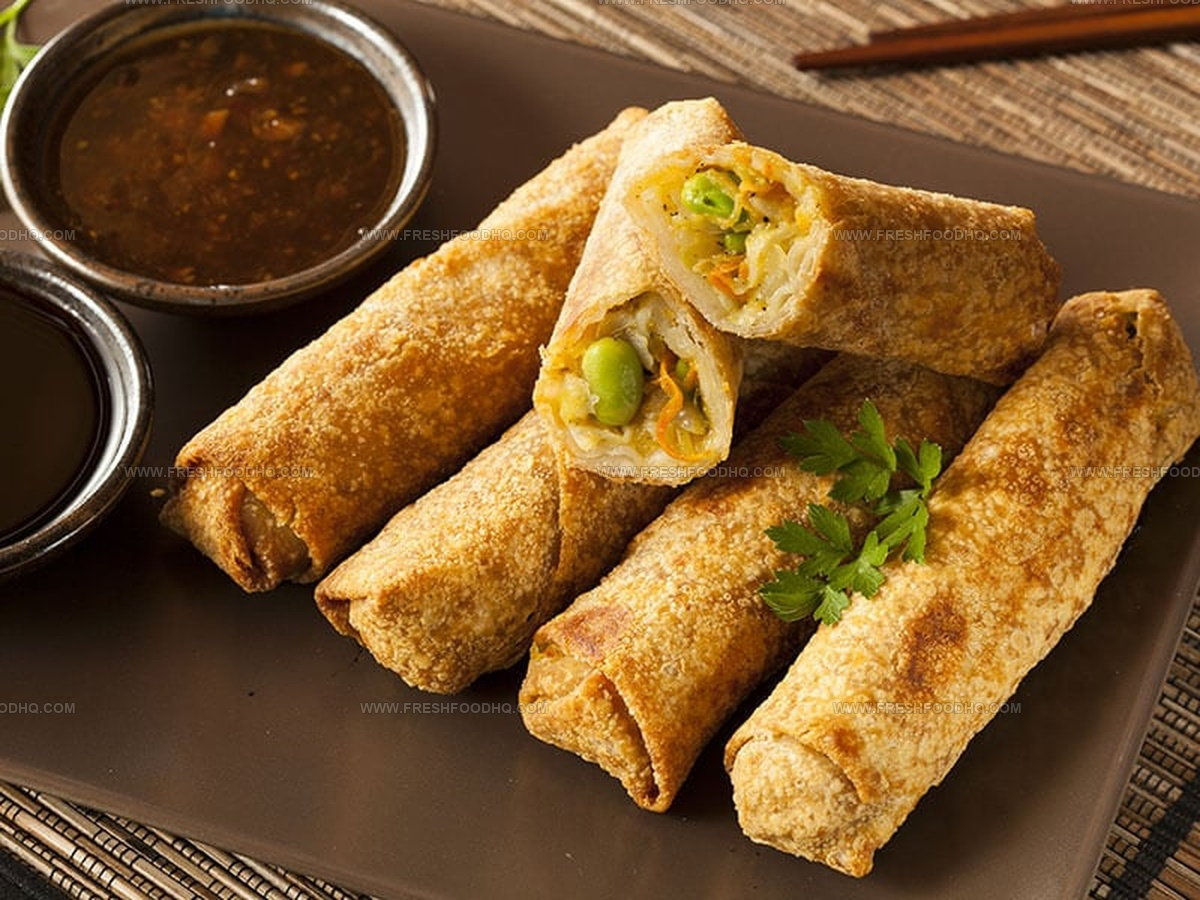
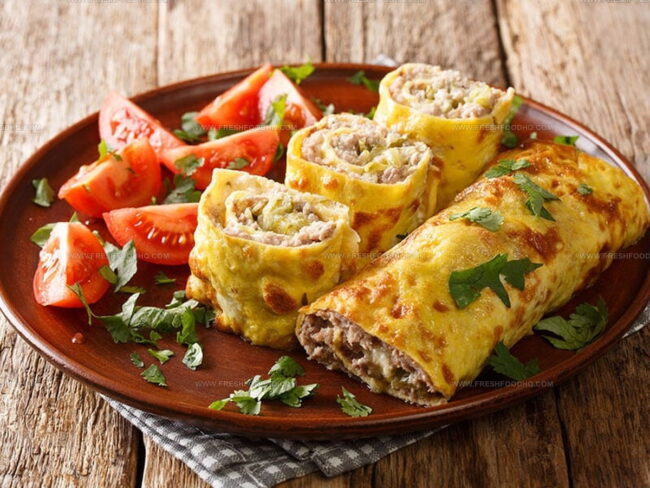
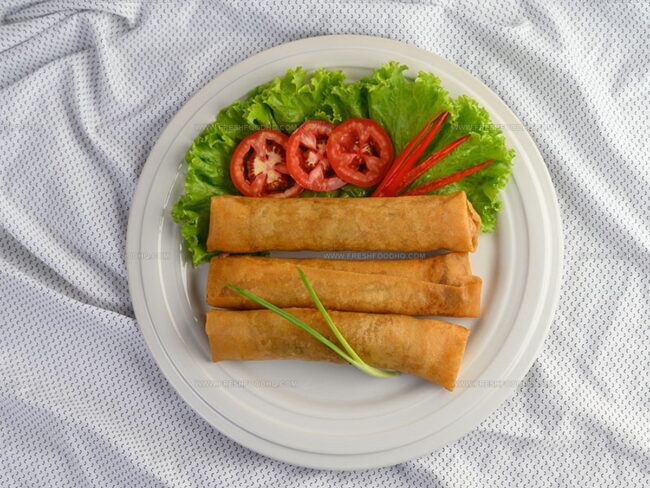
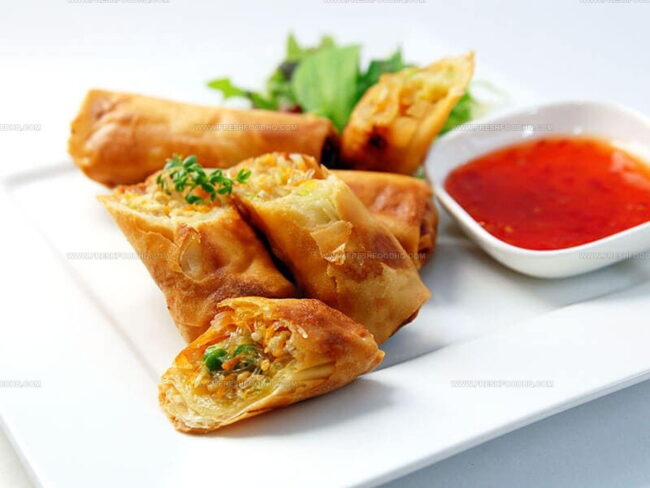
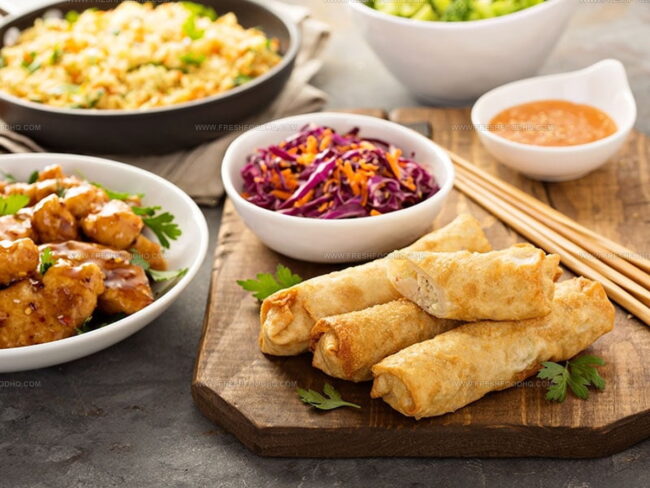
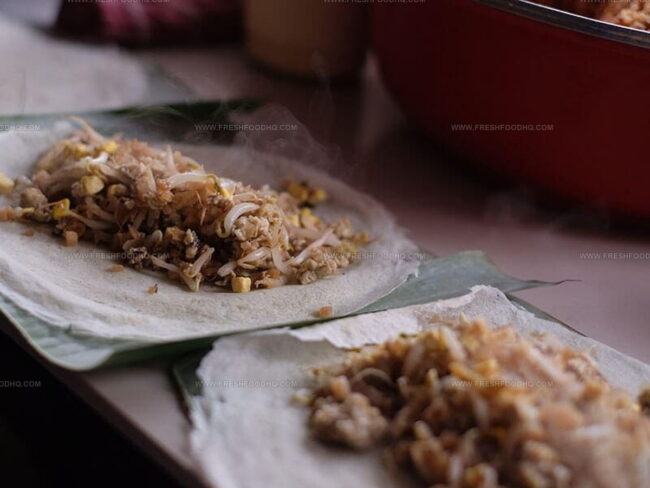
Samantha Lee
Recipe Developer & Content Creator
Expertise
Plant-based and vegetarian recipes, Recipe testing and development, Food blogging and digital content creation, Culinary education and workshops
Education
Oregon Culinary Institute (Portland, OR)
Samantha sees cooking like painting, every fresh herb, every juicy tomato, a new splash of color on a canvas.
After graduating from Oregon Culinary Institute, she blended her love of global cuisines and plant-based cooking into recipes that feel fresh, fearless, and full of heart.
Samantha’s kitchen is a place where comfort food gets a modern remix and every meal feels like a little adventure. When she’s not cooking, she’s out exploring farmers’ markets, sketching new recipe ideas, or getting her hands dirty in a community garden.